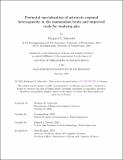Postnatal specialization of astrocyte regional heterogeneity in the mammalian brain and improved tools for studying glia
Author(s)
Schroeder, Margaret E.
DownloadThesis PDF (437.1Mb)
Advisor
Feng, Guoping
Boyden, Edward S.
Terms of use
Metadata
Show full item recordAbstract
Astrocytes are an abundant class of glial cells with critical roles in neural circuit assembly and function. Though many studies have uncovered significant molecular distinctions between astrocytes from different brain regions, the developmental trajectory of this regional heterogeneity requires further systematic study. Chapter 1 of this thesis provides a detailed literature review on the development of astrocyte regional heterogeneity. To address existing knowledge gaps, we used single-nucleus RNA sequencing to characterize the molecular diversity of brain cells across six developmental stages and four brain regions in the mouse and marmoset brain (Chapter 2). Using this transcriptomic atlas, we show that astrocyte regional specialization is shaped by postnatal development in both species, with significant species divergence in astrocyte gene expression signatures (Chapter 3). In Chapter 4, we report multiplexed expansion revealing (multiExR), a technique that can be used to visualize 20 or more proteins at nanoscale resolution in the same tissue sample. Finally, in Chapter 5, we describe the generation and characterization of Gpr17-Cre, a novel Cre recombinase driver line sensitive and specific for the oligodendrocyte lineage and a subset of astrocytes in the central nervous system.
Date issued
2025-02Department
Massachusetts Institute of Technology. Department of Brain and Cognitive SciencesPublisher
Massachusetts Institute of Technology